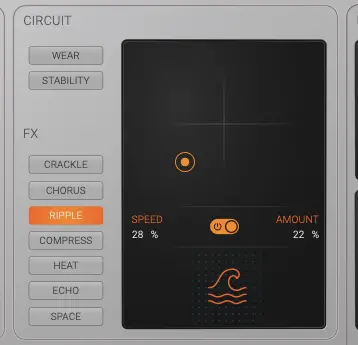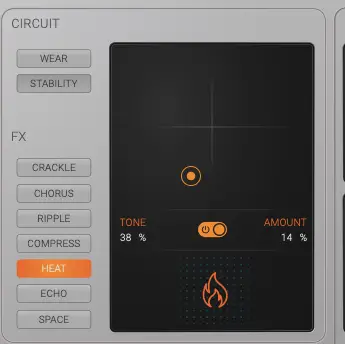Table of Contents
Yum Audio, a name that’s become synonymous with quirky, character-driven plugins, has officially stepped into the instrument game with Ember—their first-ever synthesizer. It’s an ambitious move, but one that fits perfectly with their brand. This synth isn’t about trying to do it all or competing with the kitchen-sink approach of some other companies. Instead, Ember zeroes in on analog warmth and creative imperfections, all wrapped up in a clean, no-nonsense interface.
So, what’s the big deal? In a world already saturated with synth plugins, Ember manages to carve out its space by offering something refreshingly specific: a way to inject character, texture, and analog-style quirks into your sound without getting bogged down in a sea of options.
This review takes you through Ember’s highs, lows, and the features that make it worth considering for your setup. Let’s dig in and get a closer look at what makes this synth tick.
Ember Synthesizer Review At A Glance
- What is Ember? Yum Audio’s first synthesizer, designed to bring analog warmth and imperfections into a modern, user-friendly interface.
- Why It Works: Unique effects like Crackle, Ripple, and Drift make creating textured, nostalgic sounds effortless.
- Who It’s For: Perfect for lo-fi, chillwave, ambient, synthwave, and experimental producers looking for vibe over complexity.
- Key Strengths:
- Simple interface with XY pads for intuitive sound shaping.
- 200 presets covering everything from basses to pads.
- Drift module adds organic, evolving movement to sounds.
- Shortcomings: Limited filter options and effects-heavy presets might not suit those after cleaner sounds.
What is Ember?

Ember is Yum Audio’s debut synthesizer, and it’s packed with features aimed at giving your productions an edge. Designed to bridge the gap between nostalgic analog warmth and modern sound design, Ember comes with three oscillators (saw, square, and triangle), an FM synthesis module, a sub-oscillator, and an entire suite of effects that lean heavily on emulating analog imperfections. Whether you’re after gritty textures, evolving pads, or warm leads, Ember offers a flexible canvas.
On the technical side, Ember provides an interface that’s all about accessibility. It avoids menu-diving by utilizing XY pads for many controls, making it easier for users to focus on sound creation rather than technical tweaks. This design philosophy aligns with Yum Audio’s mission—keeping creativity at the forefront without overcomplicating the process. Its low-pass resonant filter, along with crackle and ripple effects, make it a unique addition to any producer’s arsenal.
The built-in presets highlight Ember’s versatility. With 200 factory options spanning basses, leads, pads, and more, the synth is ready to deliver right out of the box and it’s super dope to see that top-level artists like Stimming and others have contributed presets to the collection. It’s compatible with major DAWs, including Ableton, FL Studio, Logic, and Pro Tools, ensuring it integrates seamlessly into existing workflows.
Pros: What Makes Ember Shine?
Unique Character and Analog Warmth
Ember leans hard into the idea of imperfection, and it thrives because of it. The “Wear” and “Stability” controls let you inject just the right amount of analog quirk—from subtle detuning to full-blown tape-style warbles. This is perfect for lo-fi producers or anyone chasing that worn-out, nostalgic vibe. Listening to Ember in action, it’s clear how much thought went into nailing this aesthetic. For instance, enabling the “Rust” parameter adds a grainy, degraded texture that feels like playing an old record through a dusty needle.
This analog authenticity feels embedded in every aspect of Ember’s design, from the subtle pitch drift to the crackling vinyl emulation. Even for clean productions, dialing in just a hint of these imperfections can add warmth and character that’s hard to replicate with other synths.
Intuitive and Accessible Interface

The user interface is another win for Ember.
Unlike some synths that drown you in options, Ember prioritizes simplicity without sacrificing functionality. Its reliance on XY pads, especially for the Circuit and FX sections, makes tweaking parameters a breeze. For example, the “Age” and “Rust” controls are integrated into a single XY pad, allowing you to balance instability and grit in one smooth motion. It’s these small design choices that keep you in the creative flow instead of fiddling with knobs endlessly.
Even beginners will find it easy to navigate, thanks to the lack of hidden menus or overly technical jargon. Everything is front and center, from the oscillator section to the master controls. Yet, for seasoned producers, there’s still plenty of depth to explore, making Ember a tool that grows with you.
Creative and Versatile FX Section
Ember’s effects are where things get really fun. The FX section feels integral to the plugin’s identity. Here’s my favorite of these modules that really sets it apart:
- Crackle: This adds subtle or heavy vinyl-style noise, giving patches an aged quality.
- Ripple: Mimics the warbling fluctuations of worn-out cassette tapes.
- Heat: A saturation effect that ranges from gentle warmth to aggressive distortion.
- Space: Offers reverb options from tight rooms to massive, atmospheric halls.






These effects don’t just complement the core sound—they become part of it. Want a pad that feels like it’s straight out of an 80s sci-fi soundtrack? Add a touch of “Ripple” and “Space.” Need a bassline with grit? Turn up the “Heat.” The integration of these effects is seamless, and the XY pads make dialing in the perfect vibe effortless.
Drift Module: Subtle Modulation Made Easy
Drift is Ember’s secret weapon for creating evolving, organic sounds. With four modes (“Slow,” “Wander,” “Peak,” and “Tape”), it can add anything from gentle fluctuations to pronounced movements. For ambient producers or anyone working on cinematic textures, Drift is a game-changer. It simulates the kind of subtle instability you’d get from analog hardware—the kind of thing that makes a sound feel alive.
While Drift isn’t as customizable as some modular synth systems, it’s a fantastic addition for quick inspiration. Pair it with the “Wear” control, and you’ve got a recipe for unique, evolving patches that stand apart in any mix.
Cons: Where Ember Falls Short
Limited Filter Options

While Ember’s low-pass filter is effective, it’s also one of its more basic features. Unlike synths that offer a range of filter types (band-pass, high-pass, etc.), Ember keeps things simple. This limitation might not bother everyone, but sound designers looking for extensive tonal shaping options may find it lacking.
For example, crafting basslines with intricate harmonic content or leads that need surgical filtering often requires more than what Ember’s filter section can provide. Still, it’s worth noting that the resonance and envelope modulation options do add some versatility.
Overreliance on Analog Effects
One of Ember’s biggest strengths can also be its Achilles’ heel. The analog-inspired effects, while impressive, can sometimes overshadow the core sound. Many presets lean heavily on crackle, wear, and ripple, which might not suit every genre or production style.
Users who prefer cleaner sounds might find themselves turning off these effects frequently, which could disrupt the otherwise smooth workflow and browsing of presets. Granted, the amount of this grit and analog flavoring as all adjustable so it’s not like you’re forced to have vinyl crackle in every single sound, it’s just worth mentioning! You can always turn down these effects if you’ve found a preset whose core vibe you dig and want to use in your track.
Use Cases: Where Ember Excels
Lo-Fi and Chill Genres
If you’re into lo-fi beats, chillwave, or anything with a retro aesthetic, Ember feels tailor-made. Its crackle and ripple effects make it effortless to create dusty, nostalgic sounds. The “Wear” control alone can turn a clean patch into something that feels like it’s been spinning on vinyl for decades.
For chillwave producers, the Drift module adds a layer of unpredictability that makes pads and leads feel alive. And when you throw in effects like “Space” and “Heat,” you can easily build lush soundscapes that sit perfectly in the mix. Whether you’re crafting a hazy downtempo track or a minimalist beat, Ember’s lo-fi capabilities make it a natural fit.
Ambient and Cinematic Productions
Ember’s Drift module and reverb effects make it a natural choice for ambient soundscapes and cinematic textures. Whether you’re scoring a film or just experimenting with evolving pads, Ember provides the tools to create deeply immersive sounds. The arpeggiator adds another layer of movement, perfect for creating rhythmic sequences that feel alive.
For sound designers working in film, the ability to layer effects like “Ripple” and “Space” can turn a simple patch into something hauntingly atmospheric. The flexibility of the Drift module also means you can design sounds that evolve over time, helping build tension or create space within a scene.
Synthwave and Retro Music
For fans of 80s-inspired production, Ember’s oscillators and FX suite are a dream come true. The sawtooth wave paired with chorus and heat effects can instantly transport you to a neon-lit world of shimmering leads and punchy basslines. The arpeggiator also plays a key role here, offering authentic retro sequences with minimal effort.
Ember’s ability to emulate analog quirks means you can recreate the feel of vintage hardware without the hassle. Its simplicity makes it easy to dial in classic sounds, while its FX section lets you add modern flair. Whether you’re aiming for a retro-futuristic vibe or a straight-up synthwave anthem, Ember delivers the goods.
Experimental Sound Design
For producers who like to push boundaries, Ember’s randomization feature and creative effects provide a playground for unconventional sound shaping. Whether you’re layering ripple with heat or using Drift to modulate time-based effects, Ember encourages experimentation without overwhelming the user.
With its unique combination of FX and intuitive controls, Ember is well-suited to avant-garde projects. The XY pads make it easy to try out new combinations, while features like Drift and “Wear” give you the tools to create sounds that evolve in unexpected ways. If you’re looking for a synth that inspires creativity, Ember is an excellent choice.
Competition: How Ember Stacks Up
Arturia Pigments
If you’ve been around the synth world for a while, you already know it’s kind of a big deal. Multiple synthesis engines, a crazy-flexible modulation system—it’s a heavyweight. But here’s the thing: that kind of power can feel like a double-edged sword. If you’re new to synthesis or just want to get right to making sounds, Pigments might feel a little… much (at least to some friends I’ve talked to who’ve dabbled with it).
This is where Ember steps in.
Ember takes the opposite approach. It’s all about simplicity and vibe. You’re not spending 15 minutes assigning modulation sources or hunting through menus. Instead, you’re tweaking a few controls, maybe dialing in some crackle or ripple, and boom—you’ve got something usable. It’s like Pigments is the scientist in the lab, and Ember’s the artist in the studio. They’re not really competitors so much as two tools for different jobs.
That’s not to say Pigments is just for the nerdy crowd—it’s an incredible synth for deep dives and experimental design. But if you’re someone who leans more on character and less on endless customization, Ember might feel like the more natural fit. They’re not stepping on each other’s toes—they’re complementing each other in the best way.
u-he Diva

Let’s get into Diva from u-he. If you’ve ever used it, you know it’s one of the most revered analog emulations out there. The warmth, the accuracy, the depth—it’s a synth lover’s dream. But there’s a trade-off: all that analog glory comes with a steep learning curve and a pretty significant CPU hit. Diva isn’t exactly something you fire up for quick ideas. That’s where Ember steps in with a completely different energy.
Ember’s lightweight design and playful interface make it a go-to for quick, vibey sounds. It’s not trying to match Diva’s realism or its encyclopedic list of filter options. Instead, it’s about delivering that analog-inspired vibe with minimal fuss. Think of it as a way to grab that analog warmth without worrying about overloading your CPU or losing your creative flow.
Diva is perfect for producers who want to replicate the exact tones of vintage hardware. It’s meticulous and incredibly powerful. But if you’re someone who likes the vibe of analog without the baggage, Ember is an easy pick. It’s less about being an emulation and more about channeling the spirit of those classic synths into something fresh and fun.
Final Thoughts
Ember isn’t trying to be the most feature-packed synth on the market. Instead, it carves out a niche by embracing analog imperfections and prioritizing usability. Its charm lies in its imperfections, from the Drift module to the crackle effect. For producers who value character and simplicity over endless tweakability, Ember is a refreshing addition to the synth landscape.
Whether you’re diving into lo-fi, ambient, synthwave, or experimental music, Ember delivers a creative toolkit that’s as inspiring as it is fun to use. While it has its limitations, the overall experience feels thoughtfully designed and incredibly rewarding. Yum Audio’s first foray into synthesizers is a strong one, and Ember proves they’re here to stay.
The post Yum Audio Ember Synthesizer Review: Your New Tool for Retro Sounds appeared first on Magnetic Magazine.



